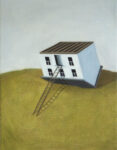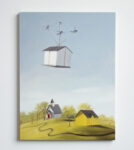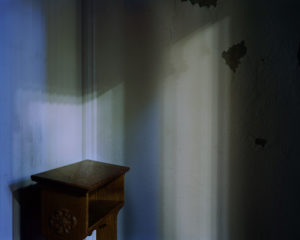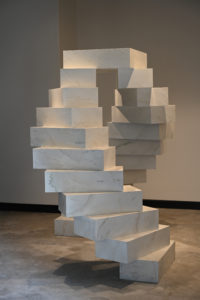Cate Pasquarelli received a BFA from the Cooper Union in May of 2020. Her work is included in the collections of Beth Rudin DeWoody as well as Jim Jarmusch and Sara Driver. She was recently awarded a programming fellowship at the Wassaic Project.
Image: You seem to find elements of pastoral American life beguiling—school buses, steepled churches, picket fences. Where does that fascination come from?
CP: There’s a kind of anonymity to those things that still somehow feels decidedly American. Books and movies paint these pastoral pictures over and over in a way that makes them feel like the language of generic American life. Maybe it’s because I grew up in a city that they seem fascinating. To me there’s something alluring about rural life simply because I’ve never lived it. I think we’re all naturally intrigued by—and maybe a little suspicious of—the worlds that are unfamiliar to us.
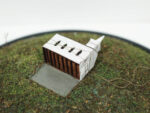
Cate Pasquarelli. Church (detail), 2021. Glass cloche, clay, basswood, green tea, thread, wire, acrylic and enamel paint, sandpaper. 13 x 10 inches.
Image: We’ve spoken about your interest in American literature, especially modern and contemporary short stories set in small towns. I’m curious what writers and themes are especially generative for your work.
CP: I love stories that make ordinary things feel strange and strange things feel ordinary. Small towns are the perfect setting for this sort of thing. Two of my favorite writers, Shirley Jackson and Flannery O’Connor, were writing during the political and cultural turbulence of the 1950s and ’60s through a sort of surreal lens. They focus on rural white America, with characters who cling to traditional values to feed their racist agendas. Both writers use whimsical elements, but their stories usually end in horrifying ways—like a woman being stoned to death by her family and neighbors or a grandmother getting shot in the road. They explore relationships between skeptics and believers, young people and old people, locals and “strangers.”
Image: Why do you think the mythology of rural America has such a pull on the American imagination?
CP: When something happens in a town where nothing happens, an entire community is turned upside down. I think that’s why myths, stories, and secrets are held more tightly in small towns than in cities, where people can hide behind their anonymity. In rural areas, neighbors know each other like their grandparents knew each other, and there is a sense of trust that can’t exist in a more populated area. It’s the perfect breeding ground for misinformation, rumors, corruption, and cults. If you are an artist or a writer, a small town is a great place to set the scene for something entirely deranged.
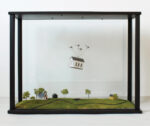
Cate Pasquarelli. Small Town, 2023. Glass case, foam, wood, wire, string, plastic, turf, sandpaper, twigs. 27 x 36 x 14 inches.
Image: Classic New England church buildings crop up often in your work, sometimes as part of the scenery, but at other times more as characters unto themselves. While the forms are of course drawn from a particular Christian vernacular, do they have further spiritual significance to you?
CP: Personally, the churches don’t hold a lot of spiritual meaning to me, as I don’t have much of a relationship to Christianity now. But they do hold significant symbolic meaning to me when I consider what fascinates me about small New England towns and what hides behind their white picket fences and smiling neighbors.
Each building in a town holds its own stories, conversations, and secrets. In a way, they feel much more like portraits of the people who have lived there than features of a landscape. The church motif comes up a lot in my work simply because churches are such a prevalent part of colonial architecture and our country’s darkest histories.
Image: What was your own experience of religion like growing up?
CP: My brother and I went to a progressive Episcopal school in Lower Manhattan where we attended chapel three times a week. By the time I was in middle school, I wondered why I was the only kid in my class not to receive communion. My parents asked a friend of theirs who was a priest to sit down with me and talk it over. They decided it was okay for me to participate as long as I knew what it meant. As a family, we never identified with any particular religion. My parents had different beliefs, and I think they wanted us to make our own decisions.
Three years ago, I returned to the same school as a teacher, and it all felt very strange to me. For one thing, only about half the students participated in chapel. I had a hard time explaining to them why they were required to be there, or why it wasn’t okay to play tic-tac-toe during the service. I still have trouble with it. I worry about how some children might feel confused or alienated by the experience. It seems to me that inclusivity is more than inviting people of different faiths to join your service. It’s also about giving them the space to opt out.
Image: The great sociologist of religion Peter Berger spoke of religion as providing a “sacred canopy” for believers in moments of existential uncertainty. You seem to paint and sculpt little enchanted worlds, then pull away the canopy by introducing a disaster that disturbs the bucolic scene. Do you imagine the inhabitants of your scenes facing crises of meaning?
CP: That’s precisely it. I think of the inhabitants as people who have managed to self-isolate for a long time and whose lives are suddenly disrupted by immense change. In this moment of crisis, some are willfully blind to disaster, while others actively push against what is unfamiliar, driving them to extreme circumstances in either case. That inner turmoil is visible in the imprint they leave on the landscape.
I often think about a story by Flannery O’Connor titled “The River.” A little boy’s babysitter brings him to a river where a revivalist preacher baptizes the boy and explains that he is loved by his heavenly father, the Lord. The boy returns home to his parents, who struggle with alcoholism and generally ignore him. In search of his other dad in the kingdom of heaven, the boy goes back to the river and drowns in the current. I think many of us are that little boy. We’re just looking for some kind of love and meaning in the world. It’s easy not to notice when it’s killing us.
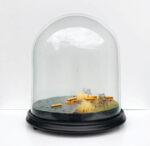
Cate Pasquarelli. Lake, 2022. Glass cloche, resin, clay, plaster, natural materials, artificial grasses, plastic, acrylic and enamel paints. 13 x 12 inches.
Image: Another way to look at your works, especially given their glass enclosures, is that they simulate specimens in a natural history museum or dioramas in an ethnographic museum. Do you think of your works as collecting or preserving a certain type of world?
CP: I wouldn’t go so far as to say that they capture a historically accurate picture of the world we’re living in. I’m telling the story of a kind of rural life I’ve never lived. But they do capture something real about the way that life appears from the outside, the way it feels.
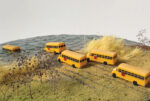
Cate Pasquarelli. Lake (detail). 2022. Glass cloche, resin, clay, plaster, natural materials, artificial grasses, plastic, acrylic and enamel paints. 13 x 12 inches.
In my last show, I created a “Museum of Embellished History” to contextualize my landscapes in a made-up town I called New Bantam. The imagery was surreal, like a plume of smoke that travels between two chimneys, or a government building being airlifted by helicopters out of a hamlet. I created a fictional artist for the works, Peter Landon, whose picture hung on a wall—a photograph of me with a mustache. Still, because I called it a museum and had a bit of wall text that told a vague story, surprisingly to me, many people believed these events had really occurred. They asked me questions like “what year was this?” and “where is New Bantam located?”
It’s interesting to me how quick we are to trust a museum’s account of history simply because it’s presented in a way that feels organized and professional. We gloss over whatever seems unappealing or doesn’t fit into the story we are trying to tell. In many ways, I think fiction can tell a more honest story than what we consider to be the truth.
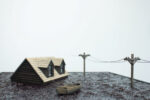
Cate Pasquarelli. Flood (detail), 2023. Plexiglass case, wood, resin, string, mylar, fabric, and wire. 55 x 25½ x 25½ inches.
Image: In an era of catastrophic climate change, the disasters you allude to seem both archetypal—like a biblical deluge—and also highly specific, reminding me of the recent floods in Vermont, for example. Would it be fair to think of your recent work as a form of witness?
CP: Strangely enough, I started working on a sculpture called Flood before the Vermont floods. What was supposed to be kind of a surreal, dramatic image now feels eerily prophetic. That overlap between dream worlds and reality interests me. I don’t even need to stretch the truth very far to make a point. The world is a strange, perverted place, and we’re living in enough of a nightmare as it is.
On the cover of issue 119: Cate Pasquarelli. Two Houses, 2021. Glass cloche, clay, basswood, cotton, artificial grasses, acrylic and enamel paint, sandpaper. 9 x 8 x 4 inches.




